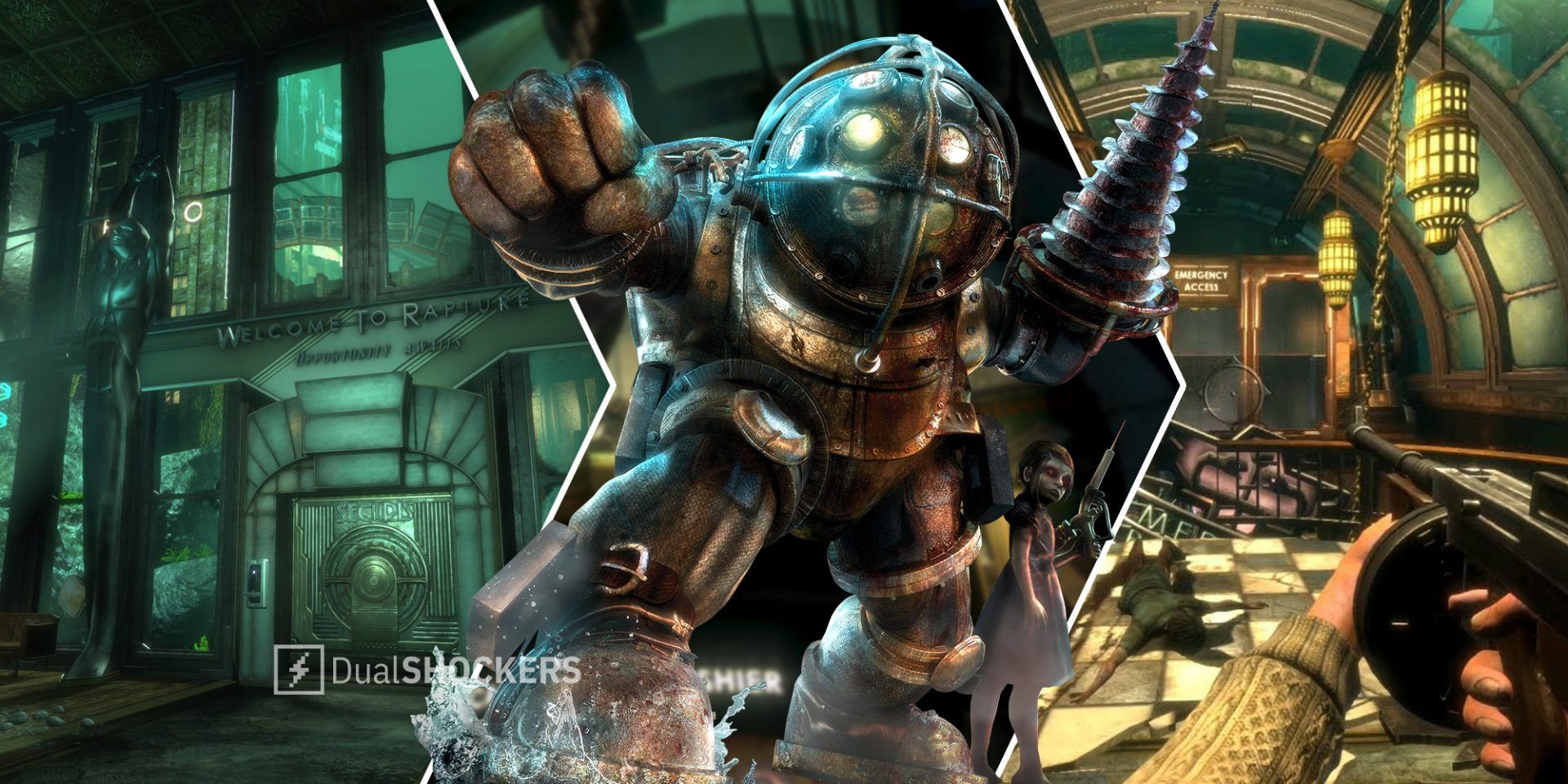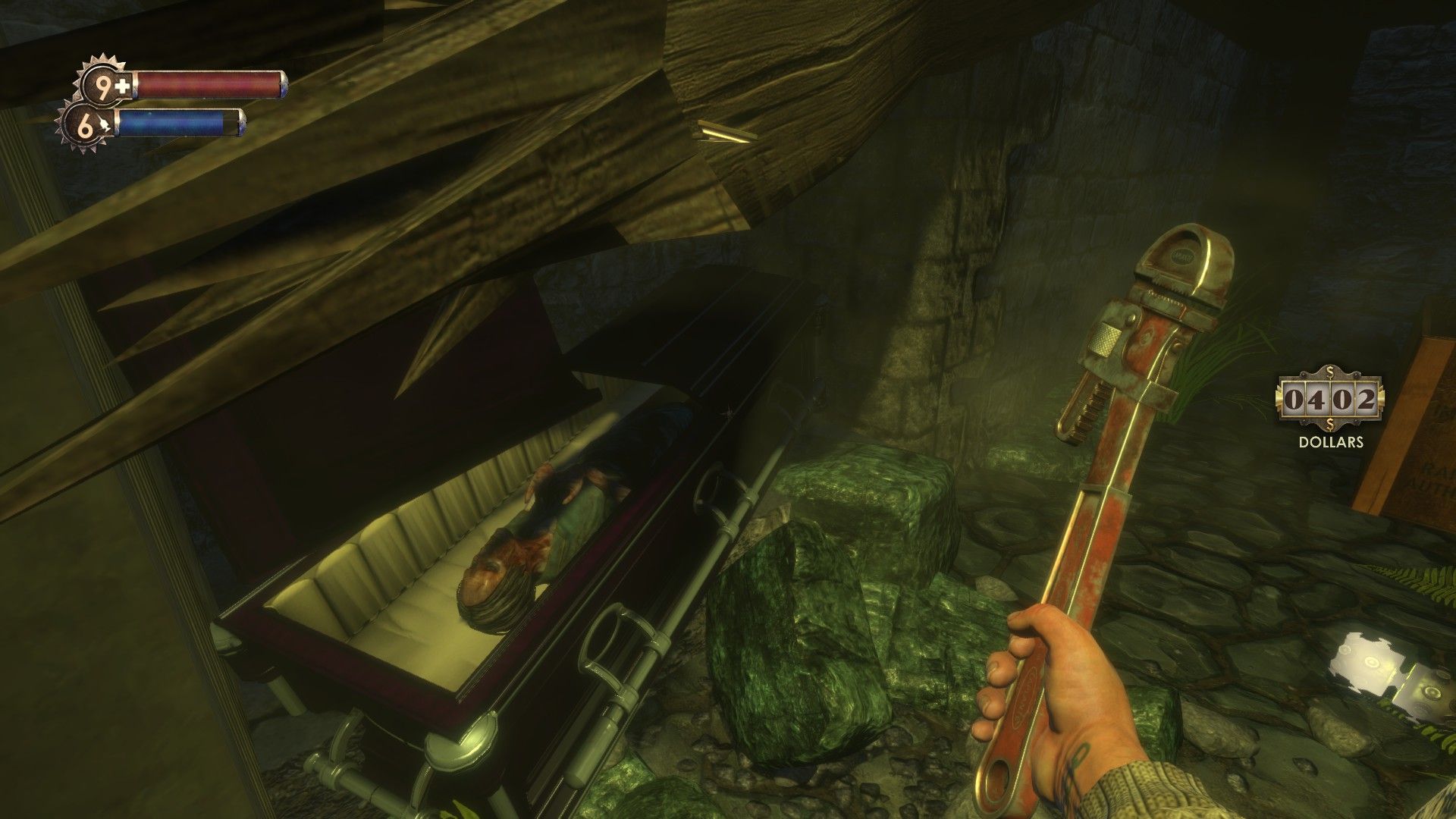Almost all my favourite moments in Bioshock are the quieter ones - the fleeting interactions through glass with the few surviving people in Rapture, a Splicer muttering madly to itself as it wanders past while I ready my wrench for its skull, a Big Daddy stomping sadly beneath the flickering neon lights and leaking pipes of the fallen underwater city. 15 years on, those same moments still shine, unblemished by the passage of time.
Just like Rapture itself retains its Deco grandeur despite the atrophy of its residents, so too does Bioshock despite being limited by the technical possibilities of 2007.
Granted, that is partly down to the fact that it's the remastered version I'm playing, but it's also testament to the game's incredible art design and singularity of its setting. The exaggerated, grotesquely cartoony, character models have aged much better than the attempted realism of contemporary games like Call of Duty 3, Assassin's Creed, or even the technical showcase of Crysis.
Rapture was one of the first videogame environments that didn't really feel like a videogame environment. It was so rich, so dense, so untropey compared to other games. Up to that point, what were the great videogame dystopias - Half-Life 2's City 17? The cyberpunk world of Deus Ex? Great visions, for sure, but reliant on well established existing ideas in popular media. The Deco bombast of Rapture - informed in equal parts by architecture and Randian philosophy - was something not really believed to have been within the creative remit of game at the time.
Of course, Rapture is a videogame environment. You explore it in a largely non-linear fashion, each chapter taking you to a different distinct section of the city, which you're at liberty to explore how you please. You can veer off the critical path, encountering scenes of disarray before picking up audio diaries that tell stories - often from beyond the grave - of the people who lived in the city. Most of your interactions with the game are through these disembodied communications, and while games had done this before (most notably Ken Levine's previous great work, System Shock 2), none had done it with such swagger.
The voice work in the game is phenomenal, and you never get the feeling that it's all just directed at you as a gamer; it was like you just happened through the ruins of a lost civilisation. The distinctly 1950s lexicon of Rapture - from its affluent socialites to its gritty proletariat - could be straight from a BBC-level radio play, as the social fabric of the city takes shape through the audio diaries of these scientists, megalomaniacs, and regular folk.
This method of world-building and storytelling remains one of the best in videogames, its effectiveness attested to by the fact that just a few years after Bioshock's release, we saw many of the same methods used in the new 'walking sim' genre that indie developers began exploring.
It's not just the echoes of the past that give Bioshock its acoustic character. There are the manic vending machines - the Circus of Value clown and El Ammo Bandito, which goes in so hard on the stereotypical Mexican bandito accent that it pushes through 'inappropriate' and comes out the other side utterly hilarious.
There's the ghostly crackling jazz that sometimes plays through the speakers in certain areas, as well as the mad ramblings of the Splicers, who may still have the best dialogue of enemy grunts in any game. The mixture of fear and fury, vanity and insecurity as their minds exist in some liminal space between their illustrious past and horrific present is both amusing and harrowing. You have the guys complaining about how lonely they are, before getting angry at some unknown woman because she keeps returning his flowers, and the independent-minded high-society lady "who just craves a little variety." And let's not forget the classic, "Jesus loves me, this I know, For the Bible tells me so..."
Top all that off with the regular clanging and creaking of a city that really seems to be feeling the weight of the whole ocean on its back, and you have a soundscape that's still capable of submerging you after all these years.
Bioshock's high-minded design ideas continue to set it apart from many other games, including the far more scripted Bioshock Infinite. The roaming AI continues to create wonderful moments of foreboding; seeing the glow of a Big Daddy's helmet light will have you frantically switching up your ammo types and making sure you have enough EVE to take on the beast, while Splicers roam the corridors like cackling packs of hyenas. Setting these different forces up to collide with each other - especially if you've hacked the local turrets and security cameras to work for you - remains one of gaming's great joys - an AI moshpit that never gets old.
Bioshock creator Ken Levine was pretty open about his belief that the game had to be a shooter at its core, because that's what 'scratched the itch' for gamers. There was a lot of back-and-forth over the years about the value of the combat in a game so strongly thematised around free will and power, and the game lacked the stealth elements you'd expect to see in such a game. The fact that Splicers and turrets can see you from a mile off with little regard for lighting conditions means that Bioshock doesn't really let me hang back, hide in the shadows, and simply observe things as much as I'd like.
Given the inevitability of gunfights in Bioshock, you may be *ahem* a little shocked to find that your health can deplete from full to zero almost instantaneously, but then you remember that even amidst the chaos of battle, the game still wants the player to think.
For a start, you should prep the battlefield by hacking Rapture's security systems so they work for you (including those adorable beeping security 'copters). You can research enemies using a camera - Pokemon Snap style - to get damage bonuses aand find their weaknesses. Then, once battle begins, there are plenty of stacks and combos you can utilise with your Plasmids; use telekinesis to hurl explodable gas canisters at enemies, electrify a whole gang of enemies when they're standing in water, freeze enemies then shatter then into icy giblets using your wrench.
Yes, enemy physics have that late 2000s ragdoll floatiness to them, but that doesn't detract from a unique shooter system, made incredibly malleable by the myriad Plasmids you choose to kit yourself out with. My one issue with it is the fact that you wield Plasmids in your left hand, weapons in your right, and yet the devs didn't yet make the connection to let the player to use both at once. Just three years later, Bioshock 2 would address this oversight, but today in 2022 it's one of the more glaring issues with the game, and forces you into a weapon-swapping system that's cumbersome both on keyboard and controller (on that note, how anyone can play this game on a controller is beyond me - it's a nightmare, and makes some of the Pipe Dream hacking games nigh-on impossible).
But it's to Bioshock's great credit that that's its most glaring problem when played today (that, and the fact that 'Arcadia Merlot' wine actually says Cabernet Sauvignon on the label). To stretch that wine aside into an analogy, Bioshock really has aged like a fine Arcadia Merlot. It remains one of gaming's great explorations of one of gaming's greatest environments, even if you can see through Atlas' bullshit like you can see Rapture's glorious skyline (sealine?) through its oddly pristine glass corridors.
I give it 11 harvested Little Sisters out of 10 rescued ones.


